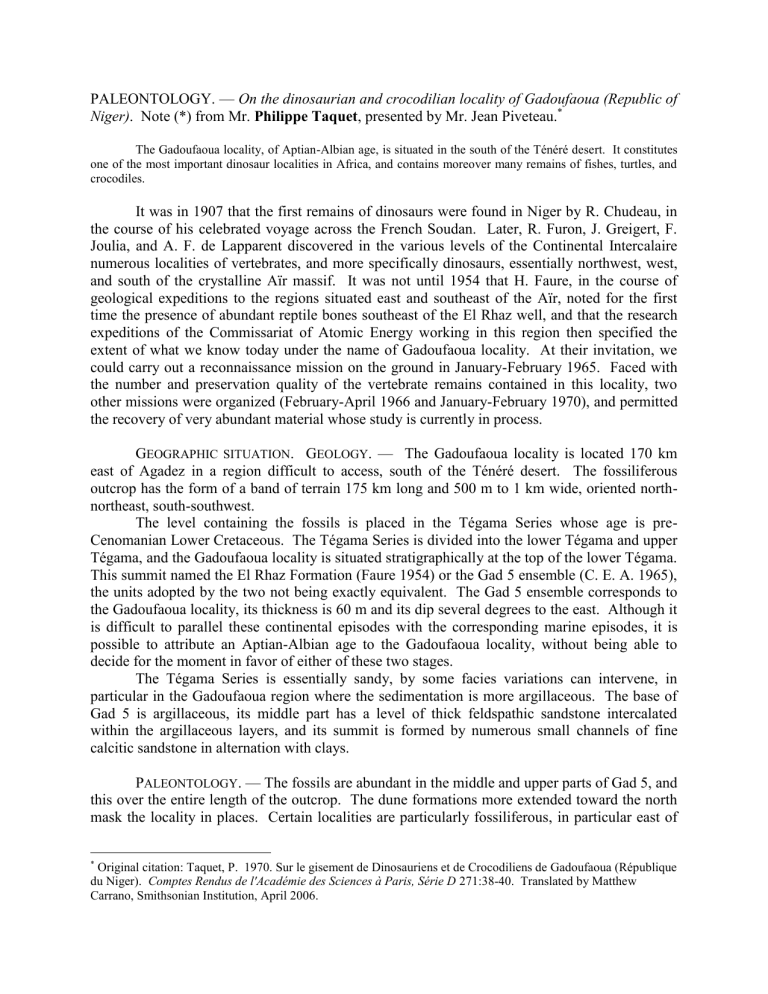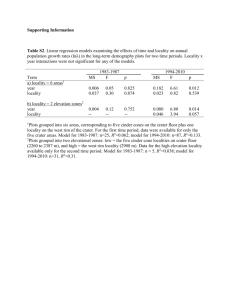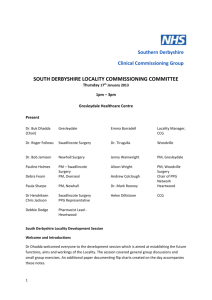PALEONTOLOGY

PALEONTOLOGY. — On the dinosaurian and crocodilian locality of Gadoufaoua (Republic of
Niger) . Note (*) from Mr. Philippe Taquet , presented by Mr. Jean Piveteau.
*
The Gadoufaoua locality, of Aptian-Albian age, is situated in the south of the Ténéré desert. It constitutes one of the most important dinosaur localities in Africa, and contains moreover many remains of fishes, turtles, and crocodiles.
It was in 1907 that the first remains of dinosaurs were found in Niger by R. Chudeau, in the course of his celebrated voyage across the French Soudan. Later, R. Furon, J. Greigert, F.
Joulia, and A. F. de Lapparent discovered in the various levels of the Continental Intercalaire numerous localities of vertebrates, and more specifically dinosaurs, essentially northwest, west, and south of the crystalline Aïr massif. It was not until 1954 that H. Faure, in the course of geological expeditions to the regions situated east and southeast of the Aïr, noted for the first time the presence of abundant reptile bones southeast of the El Rhaz well, and that the research expeditions of the Commissariat of Atomic Energy working in this region then specified the extent of what we know today under the name of Gadoufaoua locality. At their invitation, we could carry out a reconnaissance mission on the ground in January-February 1965. Faced with the number and preservation quality of the vertebrate remains contained in this locality, two other missions were organized (February-April 1966 and January-February 1970), and permitted the recovery of very abundant material whose study is currently in process.
G EOGRAPHIC SITUATION . G EOLOGY . — The Gadoufaoua locality is located 170 km east of Agadez in a region difficult to access, south of the Ténéré desert. The fossiliferous outcrop has the form of a band of terrain 175 km long and 500 m to 1 km wide, oriented northnortheast, south-southwest.
The level containing the fossils is placed in the Tégama Series whose age is pre-
Cenomanian Lower Cretaceous. The Tégama Series is divided into the lower Tégama and upper
Tégama, and the Gadoufaoua locality is situated stratigraphically at the top of the lower Tégama.
This summit named the El Rhaz Formation (Faure 1954) or the Gad 5 ensemble (C. E. A. 1965), the units adopted by the two not being exactly equivalent. The Gad 5 ensemble corresponds to the Gadoufaoua locality, its thickness is 60 m and its dip several degrees to the east. Although it is difficult to parallel these continental episodes with the corresponding marine episodes, it is possible to attribute an Aptian-Albian age to the Gadoufaoua locality, without being able to decide for the moment in favor of either of these two stages.
The Tégama Series is essentially sandy, by some facies variations can intervene, in particular in the Gadoufaoua region where the sedimentation is more argillaceous. The base of
Gad 5 is argillaceous, its middle part has a level of thick feldspathic sandstone intercalated within the argillaceous layers, and its summit is formed by numerous small channels of fine calcitic sandstone in alternation with clays.
P ALEONTOLOGY . — The fossils are abundant in the middle and upper parts of Gad 5, and this over the entire length of the outcrop. The dune formations more extended toward the north mask the locality in places. Certain localities are particularly fossiliferous, in particular east of
* Original citation: Taquet, P. 1970. Sur le gisement de Dinosauriens et de Crocodiliens de Gadoufaoua (République du Niger). Comptes Rendus de l'Académie des Sciences à Paris, Série D 271:38-40. Translated by Matthew
Carrano, Smithsonian Institution, April 2006.
the El Rhaz well and east of the Eméchédoui well. In this last locality, the dinosaurs lie on the ground, uncovered by the sandy wind. Eight skeletons of ornithopods are thus visible on a surface of 10,000 m 2 . The bones are well preserved, impregnated with calcite, but sometimes worn by the particularly intense eolian erosion in this region.
The collections made permit us to give a preliminary outline of the flora and fauna of this locality. The remains of homoxylous wood are abundant (notably Protophyllocladoxylon chudeaui ) as well as the silicified structures of a Filicales: Paradoxopteris stromeri . In certain localities, freshwater lamellibranchs strew the ground ( Margaritifera , Cuneoopsis , Hyriopsis ), some still grouped in life position, others found dispersed amid the dinosaur skeletons.
Numerous fishes are present in the locality, notably a genus of selachian ( Hybodus ) recognizable from its dorsal spines, two representatives of the actinopterygians with a semionotid ( Lepidotes ) on the one hand and a pycnodontid on the other: this fish fauna also includes a genus of crossopterygian ( Mawsonia ) and two species of dipnoans ( Ceratodus africanus and Ceratodus tiguidensis ). The remains of crocodilians are very abundant and belong on the one hand to a giant, long-snouted form ( Sarcosuchus imperator ), whose complete 1.60 m long skull was recovered, and on the other hand to a small, brevirostrine form not yet identified. The presence of two species of pleurodire turtles is attested to by the recovery of material including several carapaces, vertebrae, and limb bones.
The dinosaurs are abundant, and up to now we have been able to characterize in the
Gadoufaoua locality the existence of a coelurosaurian, a theropod with small teeth and gracile limbs belonging to the genus Elaphrosaurus , a carnosaurian of large size with dagger-bladed teeth belonging to the genus Carcharodontosaurus , and a small sauropod of which numerous skeletal elements from the same individual were recovered in March 1970. This sauropod possessed needle-shaped teeth and was connected by this fact to the titanosaurids, to which belong in particular the African genera Barosaurus and Dicraeosaurus from the Upper Jurassic of Tendaguru (Tanzania). Finally the ornithopods are numerous, and a practically complete skeleton of an iguanodontid was recovered in 1966. This is more gracile than Iguanodon mantelli and Iguanodon bernissartensis from the Lower Cretaceous of Europe, and the neural arches of its dorsal vertebrae are extraordinarily elongated. The skeleton of another ornithopod, a little more complete, was also recovered in 1966, and it differs from the first by the proportions of its forelimbs, very robust and massive and seeming to show a tendency toward quadrupedalism.
The inventory of the fauna of this locality is far from being ended. The good preservation of the fossils that it contains has permitted a French paleontological mission to recover for the first time a complete dinosaur skeleton. The extend and richness of this locality, still unsuspected a few years ago, makes Gadoufaoua one of the most important dinosaur localities in Africa. The only locality that is comparable to it in importance on this continent is the Tendaguru locality (Tanzania) studied by German paleontologists from 1911 to 1913; it can be compared to the other great dinosaur localities from the rest of the world, such as those well known from North American or Mongolia.
(*) Session of 22 June 1970.
(Institut de Paléontologie, Muséum d’Histoire Naturelle,
8, rue de Buffin, 75-Paris, 5 e .)







